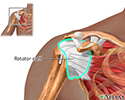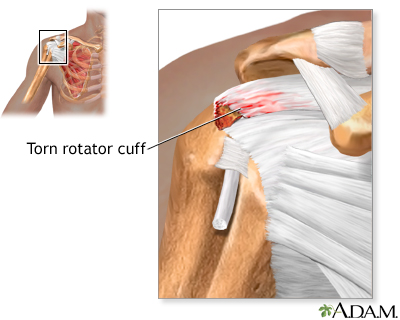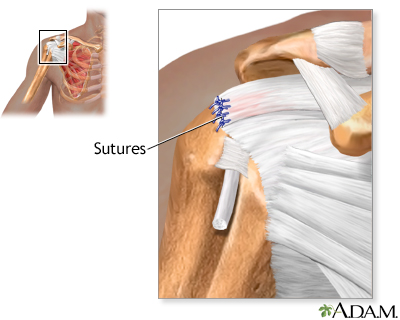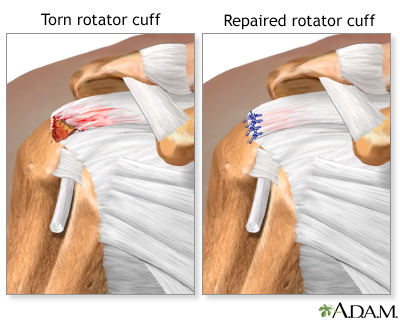Rotator cuff repair
Surgery - rotator cuff; Surgery - shoulder - rotator cuff; Rotator cuff repair - open; Rotator cuff repair - mini-open; Rotator cuff repair - laparoscopic
Rotator cuff repair is surgery to repair a torn tendon in the shoulder. The procedure can be done with a large (open) incision or with shoulder arthroscopy , which uses small buttonhole-sized incisions.
Shoulder arthroscopy
Shoulder arthroscopy is surgery that uses a tiny camera called an arthroscope to examine or repair the tissues inside or around your shoulder joint. ...

Description
The rotator cuff is a group of muscles and tendons that form a cuff over the shoulder joint. These muscles and tendons hold the arm in its joint and help the shoulder joint to move. The tendons can be torn from overuse or injury.
You will likely receive general anesthesia before this surgery. This means you will be asleep and unable to feel pain. Or, you will have regional anesthesia. Your arm and shoulder area will be numbed so that you do not feel any pain. If you receive regional anesthesia, you will also be given medicine to make you very sleepy during the operation.
Three common techniques are used to repair a rotator cuff tear:
- During open repair, a surgical incision is made and a large muscle (the deltoid) is gently moved out the way to do the surgery. Open repair is done for large or more complex tears.
- During arthroscopy, the arthroscope is inserted through small incision. The scope is connected to a video monitor. This allows the surgeon to view the inside of the shoulder. One to three additional small incisions are made to allow other instruments to be inserted.
- During mini-open repair, any damaged tissue or bone spurs are removed or repaired using an arthroscope. Then during the open part of the surgery, a 2- to 3-inch (5 to 7.5 centimeters) incision is made to repair the rotator cuff.
To repair the rotator cuff:
- The tendons are re-attached to the bone.
- Small rivets (called suture anchors) are often used to help attach the tendon to the bone. The suture anchors can be made of metal or material that dissolves over time, and do not need to be removed.
- Sutures (stitches) are attached to the anchors, which tie the tendon back to the bone.
At the end of the surgery, the incisions are closed, and a dressing is applied. If arthroscopy was performed, most surgeons take pictures of the procedure from the video monitor to show you what they found and the repairs that were made.
Why the Procedure Is Performed
Reasons rotator cuff repair may be done include:
- You have shoulder pain when you rest or at night, and it has not improved with exercises over 6 to 12 months.
- You are active and use your shoulder for sports or work.
- You have weakness and are unable to do everyday activities.
Surgery is a good choice when:
- You have a large or a complete rotator cuff tear.
- A tear was caused by a recent injury.
- The tendons of the rotator cuff were not already torn from chronic rotator cuff problems.
A partial tear may not require surgery. Instead, rest and exercise are used to heal the shoulder. This approach is often best for people who do not place a lot of demand on their shoulder. Pain can be expected to improve. The tear may become larger over time.
Risks
Risks of anesthesia and surgery in general are:
- Allergic reactions to medications
- Problems breathing
- Bleeding, blood clots, infection
Risks rotator cuff surgery are:
- Failure of surgery to relieve symptoms
- Injury to a tendon, blood vessel or nerve
Before the Procedure
Tell your health care provider what medicines you are taking. This includes medicines, supplements, or herbs you bought without a prescription.
During the 2 weeks before your surgery:
- You may be asked to stop taking medicines that make it harder for your blood to clot. These include aspirin, ibuprofen (Advil, Motrin), naproxen (Naprosyn, Aleve), and other medicines.
- Ask your provider which medicines you should still take on the day of your surgery.
- If you have diabetes, heart disease, or other medical conditions, your surgeon will ask you to see your doctor who treats you for these conditions.
- Tell your provider if you have been drinking a lot of alcohol, more than 1 or 2 drinks a day.
- If you smoke, try to stop. Ask your provider for help. Smoking can slow wound and bone healing.
- Tell your surgeon about any cold, flu, fever, herpes breakout, or other illness you may have before your surgery.
On the day of surgery:
- Follow instructions on when to stop eating and drinking.
- Take the medicines your surgeon told you to take with a small sip of water.
-
Follow instructions on when to arrive at the hospital. Be sure to arrive on time.
After the Procedure
Follow any discharge and self-care instructions you are given.
Discharge
SLAP repair - discharge; Acromioplasty - discharge; Bankart - discharge; Shoulder repair - discharge; Shoulder arthroscopy - discharge
Self-care
Shoulder surgery - using your shoulder; Shoulder surgery - after
You will be wearing a sling when you leave the hospital. Some patients also wear a shoulder immobilizer. This keeps your shoulder from moving. How long you wear the sling or immobilizer will depend on the type of surgery you had.
Recovery can take 4 to 6 months, depending on the size of the tear and other factors. You may have to wear a sling for 4 to 6 weeks after surgery. Pain is usually managed with medicines.
Physical therapy can help you regain the motion and strength of your shoulder. The length of therapy will depend on the repair that was done. Follow instructions for any shoulder exercises you are told to do.
Shoulder exercises
The rotator cuff is a group of muscles and tendons that attach to the bones of the shoulder joint, allowing the shoulder to move and keeping it stabl...

Outlook (Prognosis)
Surgery to repair a torn rotator cuff is usually successful in relieving pain in the shoulder. The procedure may not always return strength to the shoulder. Rotator cuff repair can require a long recovery period, especially if the tear was large.
When you can return to work or play sports depends on the surgery that was done. Expect several months to resume your regular activities.
Some rotator cuff tears may not fully heal. Stiffness, weakness, and chronic pain may still be present.
These poorer results are more likely when the following are present:
- The rotator cuff was already torn or weak before the injury.
- Larger tears.
- After-surgery exercise and instructions are not followed.
- Older patients (over age 65).
- Smoking.
References
DeBerardino TM, Scordino L. Shoulder arthroscopy. In: Miller MD, Thompson SR, eds. DeLee and Drez's Orthopaedic Sports Medicine: Principles and Practice. 4th ed. Philadelphia, PA: Elsevier Saunders; 2015:chap 45.
Miller RH III, Asar FM, Throckmorton TW. Shoulder and elbow injuries. In: Canale ST, Beaty JH, eds. Campbell's Operative Orthopaedics . Philadelphia, PA: Elsevier Mosby; 2013:chap 46.
Sperling JW. Open rotator cuff replair. In: Cole BJ, Sekiya JK. Surgical Techniques of the Shoulder, Elbow, and Knee in Sports Medicine . 2nd ed. Philadelphia, PA: 2013:chap 24.
Review Date: 5/9/2015
Reviewed By: C. Benjamin Ma, MD, Assistant Professor, Chief, Sports Medicine and Shoulder Service, UCSF Department of Orthopaedic Surgery, San Francisco, CA. Also reviewed by David Zieve, MD, MHA, Bethanne Black, and the A.D.A.M. Editorial Team.





